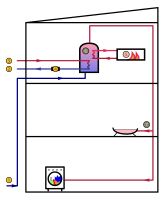
Photo from wikipedia
Abstract Water heating represents a large fraction of energy consumption in the residential sector, and it has significant health, economic, and environmental implications. However, it is well known that temperatures… Click to show full abstract
Abstract Water heating represents a large fraction of energy consumption in the residential sector, and it has significant health, economic, and environmental implications. However, it is well known that temperatures between 20 °C and 42 °C promote the multiplication of Legionella species, which are the causative agent of the Legionnaires' disease, a life-threatening form of pneumonia. Conventional tank water heating systems could be reservoirs of Legionella species, and that is why the replacement of these systems with tankless point-of-use water heating (POUWH) systems may keep a low-risk concentration of Legionella pneumophila in the water delivery and reduce energy consumption. This strategy may attain its maximum effectiveness in continental climate regions like Kazakhstan, where water mains-supply does not exceed 20 °C all year-round. Nevertheless, as POUWH systems depend on electricity, greenhouse gas (GHG) emissions may change compared to storage-based or even in-line water heating systems, depending on the energy source of grid electricity and the base-case heating system. This study assesses the use of POUWH systems in Nur-Sultan city, the capital of Kazakhstan, and compares it with commonly used electric and natural gas storage-type water heating systems. The power grid in the country heavily depends on coal (~70%), and the present analysis demonstrates that POUWH is economically competitive and reduces the greenhouse gas (GHG) emissions when compared with electric storage-type water heating (ESWH). However, the opposite happens when POUWH is compared with natural gas storage-type water heating (NGWH). The financial analysis revealed the fuel cost as the most influential factor in economic viability. Despite its debatable economic advantage, POUWH is favored by its intrinsic lower risk of Legionella sp. concentration in delivered hot water, a crucial element that should be considered in a final decision.
Journal Title: Energy for Sustainable Development
Year Published: 2020
Link to full text (if available)
Share on Social Media: Sign Up to like & get
recommendations!